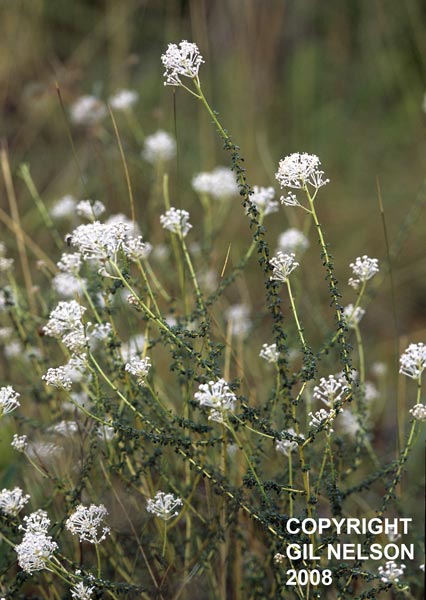Ceanothus microphyllus
| Ceanothus microphyllus | |
|---|---|

| |
| Photo by Gil Nelson | |
| Scientific classification | |
| Kingdom: | Plantae |
| Division: | Magnoliophyta - Flowering plants |
| Class: | Magnoliopsida – Dicotyledons |
| Order: | Rhamnales |
| Family: | Rhamnaceae |
| Genus: | Ceanothus |
| Species: | C. microphyllus |
| Binomial name | |
| Ceanothus microphyllus Michx. | |

| |
| Natural range of Ceanothus microphyllus from USDA NRCS Plants Database. | |
Common name: Littleleaf Buckbrush
Contents
Taxonomic notes
The specific epithet refers to the reduced leaves that are tiny rounded nubs.[1]
Synonyms: none[2]
Varieties: none[2]
Description
C. microphyllus is a perennial shrub that is in the Rhamnaceae family. It has small leaves that are less than 1/2 inch long, and usually reaches heights of 1 foot with 2-3 feet in spread.[3] This species has been observed to have several main branches near the base.[4]The flowers have obdiplostemony stamens, five clawed petals, and white. Fruits are explosively dehiscent. Mature fruits are dry, and three lobed.[5]
Distribution
It is native to Alabama, Georgia, and Florida.[6] [7] It is listed as vulnerable in Alabama and Georgia.[8] Weakley notes that C. microphyllus is found a few kilometers away from the South Carolina border, and may spread to that state.[9]
Ecology
Habitat
This species has been found in open longleaf pine-wiregrass savannahs, sandhills, ridges, slopes, and wetlands. It has been observed to grow in well-drained dry loamy sands in the uplands as well as mesic environments.[4][9]
Associated species include Pinus palustris and Aristida stricta.[4][9]
Phenology
C. microphyllus has been observed flowering from March to May and July with peak inflorescence in April.[10]
Seed dispersal
This species is thought to be dispersed by ants and/or explosive dehiscence. [11]
Fire ecology
This species occurs in mature longleaf pine communities that are frequently burned.[4]Resprouts after quick burning fire.[12]
Pollination
Pollinators are necessary for fruits to form. Many insects are attracted to the flowers.[13]
Herbivory and toxicology
Trace amounts of C. microphyllus have been found to be eaten by white-tailed deer.[14]
Conservation, cultivation, and restoration
Cultural use
Photo Gallery
References and notes
- ↑ [[1]]. Native Florida Wildflowers. Accessed: April 12, 2016
- ↑ 2.0 2.1 Weakley, A.S. 2020. Flora of the Southeastern United States. Edition of 20 October 2020. University of North Carolina at Chapel Hill, Chapel Hill, North Carolina.
- ↑ [[2]] Lady Bird Johnson Wildflower Center. Accessed: April 4, 2019
- ↑ 4.0 4.1 4.2 4.3 Florida State University Robert K. Godfrey Herbarium database. URL: http://herbarium.bio.fsu.edu. Last accessed: June 2014. Collectors: Loran C. Anderson, R. A. Norris, Andre F. Clewell, Robert K. Godfrey, Steve L. Orzell, R. Komarek and Helen Roth. States and Counties: Florida: Gadsden, Liberty, and Wakulla. Georgia: Decatur, Grady, and Thomas.
- ↑ Coile N.C. 1992. Little-leaf Redroot. Palmetto 12(1):10-11.
- ↑ USDA, NRCS. (2016). The PLANTS Database (http://plants.usda.gov, 4 April 2019).
- ↑ National Plant Data Team, Greensboro, NC 27401-4901 USA.
- ↑ [[3]]NatureServe. Accessed: April 12, 2016
- ↑ 9.0 9.1 9.2 Weakley, A. S. (2015). Flora of the Southern and Mid-Atlantic States. Chapel Hill, NC, University of North Carolina Herbarium.
- ↑ Nelson, G. PanFlora: Plant data for the eastern United States with emphasis on the Southeastern Coastal Plains, Florida, and the Florida Panhandle. www.gilnelson.com/PanFlora/ Accessed: 7 DEC 2016
- ↑ Kirkman, L. Katherine. Unpublished database of seed dispersal mode of plants found in Coastal Plain longleaf pine-grasslands of the Jones Ecological Research Center, Georgia.
- ↑ Coile N. C. 1992. Little-leaf Redroot. Palmetto 12(1):10-11
- ↑ Coile N.C. 1992. Little-leaf Redroot. Palmetto 12(1):10-11
- ↑ Harlow, R. F. (1961). "Fall and winter foods of Florida white-tailed deer." The Quarterly Journal of the Florida Academy of Sciences 24(1): 19-38.